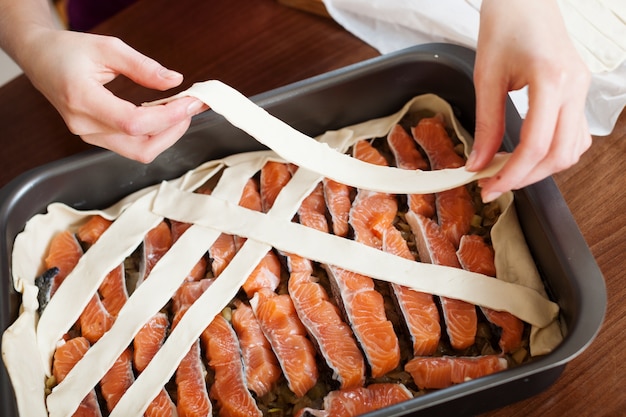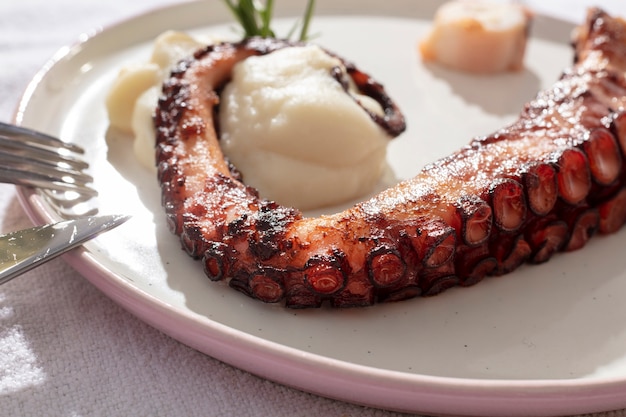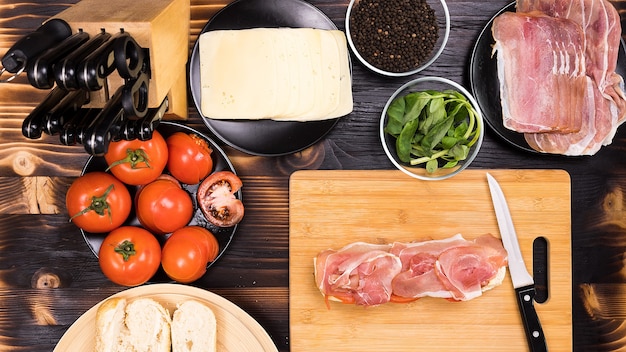(Part 1) The Basics: Why Temperature Matters

First things first, let's talk about why temperature is so crucial when cooking spiral ham. It's not just about ensuring that the meat is safe to eat. It's about creating that ideal balance of juiciness and tenderness. You see, spiral ham is typically pre-cooked, which means it's been partially cooked before it reaches your kitchen. This makes cooking it a lot easier than starting from scratch. However, it also means that overcooking can easily turn a juicy ham into a dry, rubbery mess. That's where the right temperature comes in. By carefully monitoring the internal temperature of the ham, we can ensure that the meat reaches a safe temperature while retaining its moisture. It's like a culinary dance, where we're constantly balancing safety with flavour.
(Part 2) The Magic Number: 140°F (60°C)

The golden rule when it comes to spiral ham is to cook it to an internal temperature of 140°F (60°C). This is the safe temperature recommended by the USDA (United States Department of Agriculture) for pre-cooked ham.
The Sugar Factor: Why Glazes Can Be Tricky
But here's where it gets a little more complicated: Spiral ham is often glazed or basted with sugary sauces, which can affect the internal temperature reading. Sugar has a funny way of affecting our thermometers. It caramelizes and burns at a lower temperature than the meat itself, so you might see the thermometer jump up to 140°F (60°C) before the ham is actually cooked through.
A Safe Solution: Aim for 145°F (63°C)
To compensate for this, the USDA suggests that you aim for an internal temperature of 145°F (63°C) for spiral ham that has been glazed or basted with sugary sauces. This ensures that the meat is cooked through, even with the sugary glaze.
Using a meat thermometer: A Must-Have Tool
To ensure accuracy, use a reliable meat thermometer and check the temperature in multiple spots, especially in the thickest part of the ham. Don't rely solely on the glazing or basting as an indicator of doneness.
(Part 3) Cooking Methods: Oven vs. slow cooker

When it comes to cooking spiral ham, you've got two excellent options: the trusty oven or the slow and steady slow cooker. Each method has its own advantages and disadvantages, so let's dive into both.
The oven method: Speedy and Delicious
The oven method is a classic for a reason. It's quick, efficient, and gives you a beautiful golden-brown crust.
oven cooking time:
For a spiral ham weighing 10-14 pounds, cook in a preheated oven at 325°F (160°C) for approximately 15-20 minutes per pound. This means a 10-pound ham would take about 2.5 hours.
To ensure even cooking, place the ham in a roasting pan, fat-side up, and add a little water to the bottom of the pan. The water will create steam, helping to keep the ham moist. Don't forget to baste the ham with your favorite glaze throughout the cooking process, and be sure to check the internal temperature with a meat thermometer.
The slow cooker method: Hands-Off Comfort
For those who appreciate a more relaxed approach to cooking, the slow cooker is your best friend. It's a set-and-forget method that produces a remarkably tender and succulent ham.
Slow Cooker Cooking Time:
For a spiral ham weighing 10-14 pounds, cook on low for 6-8 hours, or on high for 3-4 hours.
When using a slow cooker, it's best to avoid sugary glazes. The heat of the slow cooker can cause the sugar to burn, resulting in a sticky, caramelized mess. Instead, use a simple glaze that doesn't contain a lot of sugar, like a mustard glaze or a honey-mustard glaze.
Choosing the Right Method for You
Ultimately, the choice between the oven and the slow cooker comes down to personal preference and your available time. If you're looking for a quick and easy method, the oven is the way to go. But if you want a hands-off approach and a guaranteed tender ham, the slow cooker is the perfect option.
(Part 4) Glazing Techniques: The Finishing Touch
We've covered the basics of cooking spiral ham, but let's not forget the most important part: the glaze! A delicious glaze transforms your ham into a culinary masterpiece. It adds a burst of flavor and a gorgeous sheen that makes your ham the star of the table.
Types of Glazes
There are endless possibilities when it comes to glazing spiral ham. From classic brown sugar glazes to more creative options like mustard glazes or pineapple glazes, the sky's the limit.
Here are some popular glaze recipes to get you started:
- Classic Brown Sugar Glaze: Combine brown sugar, honey, Dijon mustard, and a little bit of apple cider vinegar for a sweet and tangy glaze.
- Honey-Mustard Glaze: This glaze is simple yet flavorful, combining honey, Dijon mustard, and a touch of garlic powder.
- Pineapple Glaze: For a tropical twist, try combining pineapple juice, brown sugar, and a little bit of orange zest.
- Spicy Chipotle Glaze: For a touch of heat, mix brown sugar, honey, adobo sauce from canned chipotle peppers, and a pinch of smoked paprika.
Glazing Tips
Here are a few tips for achieving that perfect glaze:
- Baste throughout the cooking process: Don't wait until the very end to glaze your ham. Baste it with your glaze every 30-45 minutes to ensure that the ham is evenly glazed and to prevent the glaze from burning.
- Use a brush for even application: A pastry brush is your best friend when it comes to glazing. Use it to spread the glaze evenly over the ham, ensuring that every bit is coated.
- Don't over-glaze: Too much glaze can lead to a sticky, caramelized mess. Use just enough to create a beautiful glaze without overwhelming the ham.
(Part 5) Serving and Storage: Enjoying Your Masterpiece
You've done it! You've cooked the perfect spiral ham. Now it's time to enjoy your masterpiece!
Serving Suggestions
Here are a few ways to serve your spiral ham:
- Classic Ham and Potato Dinner: Serve the ham with a side of mashed potatoes, green beans, and a creamy coleslaw for a hearty and satisfying meal.
- ham and cheese sandwiches: Slice the ham thinly and use it to make delicious sandwiches with your favorite cheese and bread.
- Ham Salad: Chop the ham into small pieces and combine it with mayonnaise, celery, and onion for a flavorful and easy-to-make salad.
- Ham and Pineapple Skewers: Cut the ham into bite-sized pieces and thread them onto skewers with chunks of pineapple. Grill or broil until the pineapple is caramelized.
Storage Tips
If you have leftover ham, here's how to store it:
- Refrigerate promptly: Once your ham has cooled down to room temperature, wrap it tightly in plastic wrap or aluminum foil and store it in the refrigerator for up to 4 days.
- Freeze for longer storage: If you want to store your ham for longer, you can freeze it. Wrap it tightly in plastic wrap and then again in aluminum foil, and store it in the freezer for up to 2 months.
(Part 6) Ham Safety and Best Practices
food safety is paramount, and it’s especially important when working with meat. Here are some key safety tips:
Safe Handling
- Wash hands: Wash your hands thoroughly with soap and warm water before and after handling raw meat.
- Clean surfaces: Wash all surfaces that come into contact with raw meat with hot, soapy water.
- Separate raw meat: Keep raw meat separate from other foods to prevent cross-contamination.
doneness testing
- Use a meat thermometer: A meat thermometer is essential for ensuring that your ham is cooked to the safe internal temperature of 140°F (60°C) or 145°F (63°C) for glazed ham.
- Check multiple spots: Check the internal temperature in multiple spots, including the thickest part of the ham, to ensure that it's cooked evenly.
Storage Guidelines
- Refrigerate promptly: Store leftover ham in the refrigerator at 40°F (4°C) or below.
- Freeze properly: If you're freezing ham, wrap it tightly in plastic wrap and then again in aluminum foil.
(Part 7) Spiral Ham: A culinary adventure
Cooking spiral ham is more than just a recipe; it’s an opportunity to experiment and get creative in the kitchen. Don't be afraid to try new glazes, explore different serving ideas, and personalize your ham to create a dish that is truly your own.
Experiment with Flavors
There’s no right or wrong way to glaze a spiral ham. Get adventurous! Try mixing different herbs and spices, incorporating fruits like pineapple or cranberries, or adding a touch of chili for a bit of heat. You can even try a maple-bourbon glaze for a more sophisticated flavor profile.
Creative Serving Ideas
Beyond the traditional ham and potato dinner, think about ways to serve your ham in a more unique way. Slice it thinly and serve it on a bed of arugula with a drizzle of balsamic glaze for a refreshing salad. Or, use it to make mini ham and cheese croissants for a delightful appetizer.
Embrace the Leftovers
Don’t throw away those precious leftovers! Spiral ham is incredibly versatile and can be used in a variety of recipes. Chop it up and add it to a quiche, use it to make a hearty soup, or even create a delicious breakfast hash. You can also use leftover ham to make a flavorful ham and cheese omelet or a savory ham and cheese bread pudding.
(Part 8) FAQs: Your Spiral Ham Questions Answered
Now let's address some common questions you might have about spiral ham.
1. Can I Cook a Spiral Ham from Frozen?
While you can technically cook a spiral ham from frozen, it’s not recommended. It will take a significantly longer cooking time, and the ham may not cook evenly.
It’s best to thaw the ham in the refrigerator overnight. To speed up the thawing process, you can place the ham in a cold water bath, changing the water every 30 minutes.
2. How Long Can I Keep Spiral Ham in the Fridge?
Once cooked, you can safely store your spiral ham in the refrigerator for up to 4 days. Make sure to wrap it tightly in plastic wrap or aluminum foil to prevent it from drying out.
3. Can I Reheat Spiral Ham?
Absolutely! You can reheat spiral ham in the oven, in a slow cooker, or in the microwave. If you're reheating it in the oven, place it in a roasting pan and cover it with aluminum foil. Reheat it at 325°F (160°C) for 15-20 minutes, or until it’s heated through.
4. What Can I Do with Leftover Ham?
Leftover ham is a gift from the culinary gods! Use it to make ham sandwiches, ham salad, ham and bean soup, or add it to a quiche. Get creative and let your imagination run wild.
5. Can I Cook a Spiral Ham on the Grill?
You certainly can! Grilling a spiral ham can add a smoky flavor and a beautiful char. Just be sure to keep the heat low and slow to prevent the ham from drying out. Use a meat thermometer to ensure that it reaches the safe internal temperature.
(Part 9) Additional Tips and Tricks
Here are some additional tips and tricks to help you achieve spiral ham perfection:
1. Scoring the Ham:
Scoring the ham before cooking helps to create a beautiful, evenly browned crust. Use a sharp knife to score the ham in a diamond pattern, making sure to cut through the fat layer.
2. Glazing Options:
Don't limit yourself to just one glaze. Try adding a drizzle of honey or a sprinkle of cinnamon to your glaze for extra flavor.
3. Adding Flavor:
For added flavor, add some aromatics to the roasting pan or slow cooker. Try adding onions, garlic, or a few sprigs of rosemary.
4. Serving with Sides:
Spiral ham is a versatile dish that pairs well with a variety of sides. Consider serving it with mashed potatoes, sweet potatoes, green beans, asparagus, or a fruit salad.
5. Using Leftovers for Soups and Stews:
Leftover spiral ham is perfect for adding flavor to soups and stews. Chop the ham into small pieces and add it to your favorite soup recipe.
Conclusion: The Perfect Spiral Ham
As you can see, the journey to a perfect spiral ham is a mix of science, technique, and a dash of culinary flair. By following these tips and embracing your own creativity, you can achieve a ham that will impress even the pickiest palates and make every gathering unforgettable. So get your ingredients ready, turn on the oven, and let the aroma of deliciousness fill your kitchen. Happy ham cooking!
Everyone is watching

Prime Rib Roast Cooking Time Chart: Per Pound Guide
Cooking TipsPrime rib roast. Just the name conjures images of lavish dinners, crackling fires, and hearty laughter. It’s ...

How Long to Bake Potatoes in the Oven (Perfect Every Time)
Cooking TipsBaked potatoes are a staple in my kitchen. They're incredibly versatile, delicious, and surprisingly easy to m...

Perfect Rice Every Time: The Ultimate Guide to Cooking Rice
Cooking TipsAs a self-proclaimed foodie, I've always been a bit obsessed with rice. It's the foundation of countless cuisi...

The Ultimate Guide to Cooking Asparagus: Tips, Techniques, and Recipes
Cooking TipsAsparagus. The mere mention of this spring delicacy conjures up images of vibrant green spears, crisp and burs...

Ultimate Guide to Cooking the Perfect Thanksgiving Turkey
Cooking TipsThanksgiving. Just the word conjures up images of overflowing tables laden with delicious food, the scent of r...
